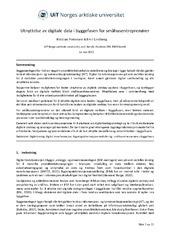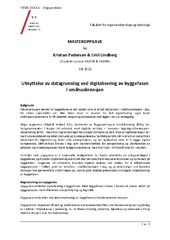| dc.contributor.advisor | Sveen, Svein-Erik | |
| dc.contributor.author | Pedersen, Kristian | |
| dc.contributor.author | Lindberg, Emil | |
| dc.date.accessioned | 2022-08-01T12:26:13Z | |
| dc.date.available | 2022-08-01T12:26:13Z | |
| dc.date.issued | 2022-05-14 | |
| dc.description.abstract | Digital transformasjon i bygge-, anleggs- og eiendomsnæringen (BAE-næringen) sees på som en felles løsning for å motvirke produktivitetsnedgangen i bransjen. Utveksling av data mellom aktører, høy automatiseringsgrad og utnyttelse av data og trekkes frem som hovedpunkter i den digitale transformasjonen. Bygningsinformasjonsmodellering (BIM) har en sentral rolle i dette og beskrives som et nav i informasjonsutvekslingen i en digital fremtid.
Huskjedene og arkitektkontorene bruker som hovedregel BIM-verktøy i tillegg til andre digitale verktøy ved prosjektering av småhus. Bruken av BIM har i stor grad vært rettet mot salgsfasen og kundeopplevelsen, mens potensialet for å utnytte det digitale datagrunnlaget i byggefasen har fått mindre oppmerksomhet. I tillegg eksisterer det digitale data i flere ledd av verdikjeden som kan komme til nytte i en byggefase.
Målet med oppgaven er å undersøke mulighetene for bedre utnyttelse av tilgjengelig datagrunnlag i byggefasen, og hvordan digitale verktøy kan benyttes for å øke arbeidsproduktiviteten, redusere byggekostnader og korte ned byggetiden. Hensikten med dette er å kunne gi råd for hvordan småhusentreprenørene kan gjennomføre omstillingen og i større grad utnytte potensialet som ligger i en mer digitalisert byggefase.
For å belyse problemstillingen er det benyttet en kombinasjon kvalitative metoder. Det har blitt gjennomført en utforskende litteraturstudie i tillegg til at 20 nøkkelpersoner fra småhusentreprenører, huskjeder og større entreprenører har blitt intervjuet.
Digitale data og verktøy har et potensial for å utnyttes bedre i byggefasen, men på nåværende tidspunkt kan det ikke fastslås om bruken har noen forretningsmessig verdi. Bruken av verktøyene er tett knyttet opp mot mennesker og arbeidsmetodikker, og det er manglende dokumentasjon av hvilke effekter bruken av digitale verktøy medfører isolert sett. God logistikkstyring, prosjektledelse og informasjonsflyt er faktorer som påvirker arbeidsproduktiviteten og byggetiden positivt, og bruken digitale verktøy kan sees på som et viktig hjelpemiddel for å ivareta dette.
Fra intervjuene av småhusentreprenørene kom det frem at det er utbredt bruk av digitale verktøy i byggefasen, men bruken varierer fra bedrift til bedrift. Verktøyene som benyttes er stort sett av lav kompleksitet og benyttes til å effektivisere enkle, eksisterende prosesser som kvalitetssikring og timeregistrering. De mest digitaliserte småhusentreprenørene tar i bruk digitale verktøy i større grad og benytter blant annet BIM-modeller i sin enkleste form til mengdeuttak, 3D-visualisering og forenklet krasjkontroll.
Generelt sett rådes småhusentreprenørene til å etablere en digitaliseringsstrategi og ta i bruk eksiterende digitale verktøy og løsninger på markedet. De bør i større grad etterspørre BIM-modeller fra arkitektene, huskjedene og leverandørene slik at de kan utnytte modellene og datainnholdet i byggefasen. Dette vil i første omgang være til enkle formål som visualisering, kollisjonskontroll, logistikk eller riggplanlegging og mengdeuttak.
Et videre arbeid bør omfatte et større perspektiv hvor utnyttelsen av datagrunnlaget sees i sammenheng med alle fasene i en bygnings livssyklus, og eventuelt hvilke økonomiske og bærekraftige fordeler dette kan medføre. | en_US |
| dc.description.abstract | Digital transformation in the construction industry is considered as a common solution to
counteract the decline in productivity in the industry. Exchange of data between actors, high
degree of automation and utilization of the data and are highlighted as main points in the digital
transformation. Building information modeling (BIM) has a central role in this and is described
as a hub in the information exchange in a digital future.
As a general rule, house chains and architectural offices use BIM-tools in addition to other
digital tools when designing small houses. The use of BIM has largely been aimed at the sales
phase and the customer experience, while the potential for utilizing the digital data base in the
construction phase has received less attention. In addition, digital data exists in several parts of
the value chain that can be useful in a construction phase.
The aim of the thesis is to investigate the possibilities for better utilization of available data in
the construction phase, and how digital tools can be used to increase labor productivity, reduce
construction costs and shorten construction time. The purpose of this is to be able to give advice
on how the small house contractors can carry out the conversion and to a greater extent utilize
the potential that lies in a more digitalized construction phase.
A combination of qualitative methods has been used to approach the topic. An exploratory
literature study has been carried out in addition to which 20 key people from small house
contractors, house chains and larger contractors have been interviewed.
Digital data and tools have the potential to be better utilized in the construction phase, but at
present it can not be determined whether the use has any commercial value. The use of the tools
is closely linked to people and work methodologies, and there is a lack of documentation of the
effects of the use of digital tools in isolation. Good logistics management, project management
and information flow are factors that positively affect work productivity and construction time,
and the use of digital tools can be seen as an important tool to improve this.
From the interviews of the small house contractors, it emerged that there is widespread use of
digital tools in the construction phase, but the use varies from company to company. The tools
used are mostly of low complexity and are used to streamline simple, existing processes such
as quality assurance and time registration. The most digitized small house contractors use
digital tools to a greater extent and use BIM models in their simplest form for quantity
extraction, 3D visualization and simplified crash control.
In general, small house contractors are advised to establish a digitization strategy and use
existing digital tools and solutions on the market. They should to a greater extent demand BIM
models from the architects, house chains and suppliers so that they can utilize the models and
data content in the construction phase. This will initially be for simple purposes such as
visualization, collision control, logistics or rig planning and quantity extraction.
Further work should include a larger perspective where the utilization of the data is seen in
connection with all phases of a building's life cycle, and possibly what economic and
sustainable benefits this may entail. | en_US |
| dc.identifier.uri | https://hdl.handle.net/10037/25878 | |
| dc.language.iso | nob | en_US |
| dc.publisher | UiT Norges arktiske universitet | en_US |
| dc.publisher | UiT The Arctic University of Norway | en_US |
| dc.rights.accessRights | openAccess | en_US |
| dc.rights.holder | Copyright 2022 The Author(s) | |
| dc.rights.uri | https://creativecommons.org/licenses/by-nc-sa/4.0 | en_US |
| dc.rights | Attribution-NonCommercial-ShareAlike 4.0 International (CC BY-NC-SA 4.0) | en_US |
| dc.subject.courseID | BYG-3900 | |
| dc.subject | VDP::Teknologi: 500::Bygningsfag: 530::Bygg-, anleggs- og transportteknologi: 532 | en_US |
| dc.subject | VDP::Technology: 500::Building technology: 530::Building, construction and transport technology: 532 | en_US |
| dc.subject | VDP::Teknologi: 500::Bygningsfag: 530::Arkitektur og bygningsteknologi: 531 | en_US |
| dc.subject | VDP::Technology: 500::Building technology: 530::Architecture and building technology: 531 | en_US |
| dc.title.alternative | Utilization of digital data in the construction phase for small house contractors | en_US |
| dc.title | Utnyttelse av digitale data i byggefasen for småhusentreprenører | en_US |
| dc.type | Master thesis | en_US |
| dc.type | Mastergradsoppgave | en_US |


 English
English norsk
norsk





